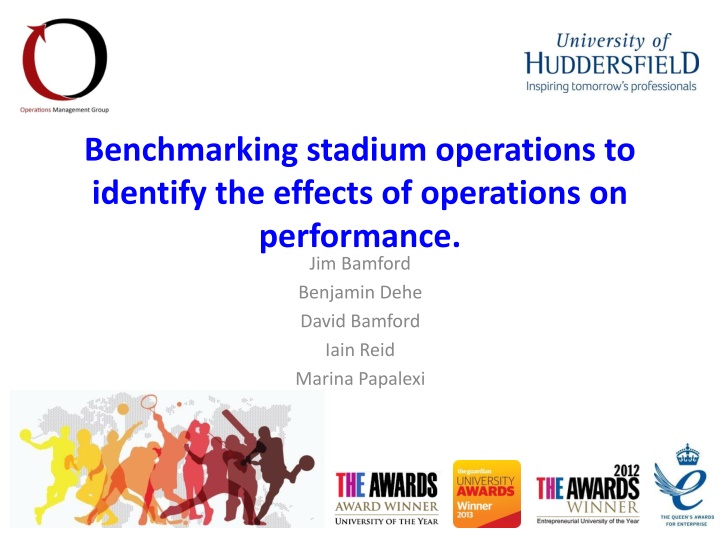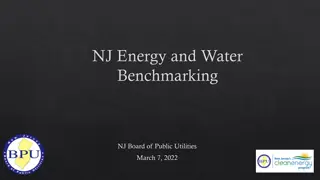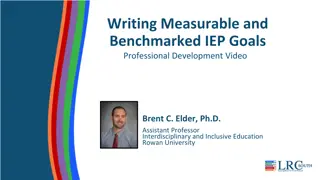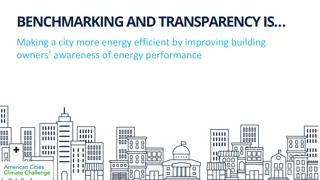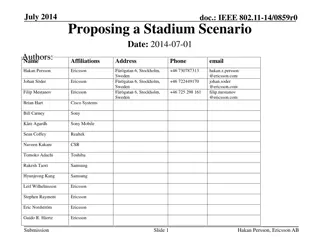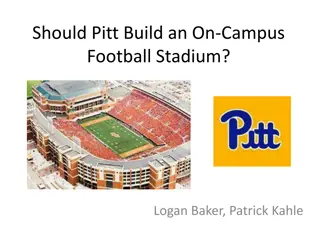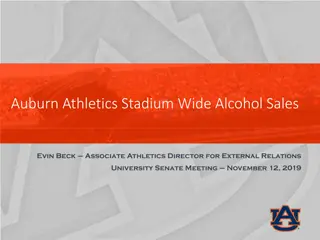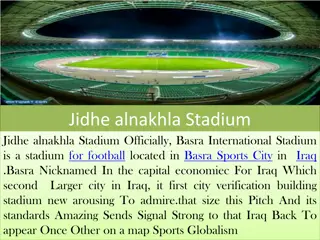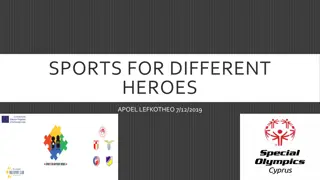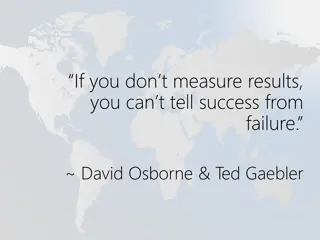Benchmarking Stadium Operations for Performance Insights
Research is progressing on operations management in sport stadiums, aiming to optimize infrastructure and operations for enhanced performance and customer satisfaction.
Download Presentation

Please find below an Image/Link to download the presentation.
The content on the website is provided AS IS for your information and personal use only. It may not be sold, licensed, or shared on other websites without obtaining consent from the author.If you encounter any issues during the download, it is possible that the publisher has removed the file from their server.
You are allowed to download the files provided on this website for personal or commercial use, subject to the condition that they are used lawfully. All files are the property of their respective owners.
The content on the website is provided AS IS for your information and personal use only. It may not be sold, licensed, or shared on other websites without obtaining consent from the author.
E N D
Presentation Transcript
Benchmarking stadium operations to identify the effects of operations on performance. Jim Bamford Benjamin Dehe David Bamford Iain Reid Marina Papalexi
Introduction Research related to operations management in sport stadiums relatively immature & underdeveloped Research to date focuses on fan or athlete satisfaction This is rather a missed opportunity as sport provides the potential for rich data and findings In the USA, the total fitness club industry revenue is sizable and is estimated to be $24.2 billion per annum (Statista, 2015)
The Aim To develop and test a benchmarking framework to assess and quantify sport infrastructure and their operation focusing on three key themes: 1. Estates and Premises 2. Services offered 3. Operations Management
Existing Literature Research into sports operations management is incoherent and confused (Wright, 2009) Very limited research into sporting facilities or layout (Bamford et al, 2017), or how the running of the stadium might affect the fan experience or outcomes (Vega-Vazquesz,2013) Some identification of operations management issues that could improve customer satisfaction (Kauppi et al, 2013; Fitzsimmons,1985; Lovelock, 1992)
Methodology A benchmarking framework based on existing literature and publicly available data was developed. Three main themes emerged: 1. Estates and Premises 2. Services offered 3. Operations Management
Ref Estates and Premises Indicator Description The stadium is recognisable and there are clear ideas behind the design reflecting the clubs values A1 Design A2 Size The stadium has an appropriate scale and feels welcoming A3 A4 Capacity and Utilisation Estates Running Costs The capacity of the stadium suits demand The total yearly premises operating costs The interior is logical, aesthetically pleasing and appropriately signposted A5 Building Layout Benchmarking Framework A6 Building Facilities Changing Rooms and player facilities are appropriate A7 Quality General and durable finish A8 Ownership How many different owners does the stadium have? A9 Age of Stadium Year opened and date of last expansion or update Services B1 Services Provision A number of extra services are provided to the consumer B2 Connectivity Does the Stadium have good wifi accessibility B3 Technology Other technological services are offered (e.g. apps) B4 B5 B6 B7 Operations Management C1 Stadium Utilisation Ticketing Sponsorship Hospitality Impact on the Community Amount taken from tickets / Tickets sold Sponsorship Services Provided Number of boxes The clubs impact on the community How often is the stadium in use There are clear designed pathways for fans and spectators C2 Consumer Pathways The fans/spectators satisfaction is assessed and corrective actions are taken Public transport, road, parking, pedestrian access C3 Consumer Satisfaction C4 Accessibility Health and Safety has clearly been taken into account (e.g. signposting, design) C5 Health & Safety
Methodology Mixed approach Qualitative and Quantitative data Primary and secondary data Stadium tours Official statistics Data translated to a 9 point scale to allow for comparisons 7
Findings City of Manchester Stadium Average per Indicator St James' Park Stamford Bridge Stadium of Light White Hart Lane Old Indicator Estates and Premises A1 A2 A3 A4 A5 A6 A7 A8 A9 Average Services B1 B2 B3 B4 B5 B6 B7 Average Operations Management C1 C2 C3 C4 C5 Average Stadium Average Wembley Emirates Anfield Trafford Riverside 9 9 9 9 7 7 7 9 5 5 9 9 9 3 5 9 9 9 7 3 3 3 7 7 9 7 9 5 7 7 7 9 3 9 7 9 9 7 7 7 3 7 7 9 9 9 7 7 7 9 7 7 7 9 5 7 7 5 7 5 7 7 5 3 3 3 3 9 5 5 5 9 9 7 9 9 5 7 9 7 5 9 9 7 5 1 7 9 9 5 7 6.8 6.8 6.4 6 6 7.8 7.6 7.4 6.87 7.89 7.44 6.11 7.00 7.22 7.67 6.11 5.00 7.44 6.78 9 7 5 7 9 9 9 9 3 5 5 9 7 9 5 7 3 7 9 9 3 7 3 5 7 9 7 7 7 7 9 7 9 7 9 7 1 1 7 5 5 9 7 7 7 7 7 5 9 3 5 1 7 7 9 3 9 5 9 5 9 9 7 7 9 9 9 7 3 7 7 5.4 5.4 6.8 8 7 7.2 6.69 7.86 6.71 6.14 6.43 7.86 5.00 7.00 5.00 7.57 7.29 9 7 5 9 9 9 3 9 7 3 3 7 9 5 9 7 3 5 5 5 5 3 7 7 9 9 7 3 5 3 7 5 3 7 5 3 9 3 3 7 5 5 9 9 7 3 9 3 7 7 5 9 5.2 5.8 6.4 5.8 7.2 6.08 7.8 6.2 6.6 4.6 5.4 4.6 7.4 6.2 7.86 6.90 6.24 6.33 7.38 6.05 6.24 4.90 7.48 6.81 6.62
Discussion Benchmarking scores Context is needed to explain some of the scoring Benchmarking framework and Methodology Conflicting data from different sources Tours not representative of actual operations Subjective nature of qualitative indicators Data translation
Conclusions Benchmarking in this setting is a useful tool to compare the operations management of different sporting stadiums The framework developed needs to be improved, other sources of data need to be considered, and the methodology needs to be adapted The sample needs to be expanded, and needs to include other sporting venues
Thank you! Any Questions?
References Bamford.D, and Dehe.B (2013), Servicescape in Sports: levels of fan satisfaction in a UK Rugby League Club , in proceedings of 20th International Annual EurOMA Conference, Dublin, Ireland. Bamford, D., and Dehe, B. (2015) Service quality at the London 2012 Games a Paralympics Athletes Survey. International Journal of Quality & Reliability Management Bamford, D., Dehe, B., Reid, I., Bamford, J. and Papalexi, M. (2017) POM for sports . In: The Routledge Companion to Production and Operations Management. Oxford, UK: Routledge. p. 28 Fitzsimmons, J.A. (1985),Consumer participation and productivity in service operations, Interfaces, Vol. 15 No. 3, pp. 60-67. Howat, G. Murray, D. Crilley, G. (1999), The relationship between service problems and perceptions of service quality, satisfaction and behavioural intentions of Australian public sports and leisure centre customers, Journal of Park and Recreation Administration, Vol. 17, No. 2, pp. 42 64 Kauppi.K, Moxham.C, and Bamford.D. (2013) Should we try out for the major leagues? A call for research in sports operations management, International Journal of Operations and Production Management, 33 (10):1368-1399. Lovelock, C. (1992), Strategies for managing capacity-constrained resources, in Lovelock, C. (Ed.), Managing Services: Marketing, Operations and Human Resources, Prentice-Hall, Englewood Cliffs, NJ. Parasuraman, A. Zeithaml, V. Berry, L. (1985), A conceptual model of service quality and its implication for future research, Journal of Marketing, Vol. 49, pp. 41 50. Statista the statistics portal (2015) U.S. fitness center / health club industry revenue from 2000 to 2014 (in billion U.S. dollars) , http://www.statista.com/statistics/236120/us-fitness-center- revenue/ accessed 21 /07/15 Vega-Vazquez, M., Revilla-Camacho, M., and Coss o-Silva, F. (2013),"The value co-creation process as a determinant of customer satisfaction", Management Decision, Vol. 51 Iss 10 pp. 1945 - 1953
